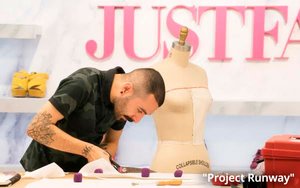 The final four contestants in the current 15th season of “Project Runway” -- the ones who made it to
New York fashion week -- were identified in Thursday night’s show on Lifetime.
The final four contestants in the current 15th season of “Project Runway” -- the ones who made it to
New York fashion week -- were identified in Thursday night’s show on Lifetime.
But the real award winners on this show are the people behind the scenes
who somehow manage to cram so many sponsorships into every single episode. Their achievement is breathtaking.
This isn’t a complaint about that either,
although that would be easy to do. A critic could easily choose to decry the blatant way that sponsors’ logos, products and pitchmen are “integrated” into this show.
Of course, the word “integrated” implies a certain seamlessness to all these in-show sponsorships, but make no mistake: There’s nothing subtle about them.
They are in your face, on the walls, in the backgrounds, and in the scripts.
advertisement
advertisement
Yes, one might be tempted to gripe, but it’s also possible to sit there
with open mouth and slack jaw just marveling at the whole thing. Thursday night’s show was a case in point (as are all of “Project Runway’s” episodes, come to think of
it).
On Thursday night, the star “guest” brand on “Project Sponsorship” was Best Western Hotels and Resorts. The lodging and
hospitality brand was the focal point of a trip the final five contestants took to Austin, Texas.
The reason for their trip was ostensibly to draw
inspiration from the quirky capital of the Lone Star State for a design challenge that would have them constructing unconventional outfits from objects they managed to grab during two shopping sprees.
One was at a farm supply store, and the other was at an Austin barbecue mecca with a large souvenir emporium attached to it.
The contestants stayed in a
spanking new Best Western that they couldn’t stop talking about -- from the mod décor and comfy beds to the shimmering outdoor pool. You knew they had been put up to all the ooh-ing and
ah-ing, but the fact that they had been so obviously coached to kvell about this hotel chain was more awe-inspiring than it was off-putting.
Back in the New
York workroom, they were surrounded, as usual, by the show’s core sponsors -- the ones that have been billboarded and featured on the show for the entire season.
“Don’t forget to make good use of the Just Fab accessories wall!” mentor Tim Gunn counseled them, as he does every week to draw attention to this wall of shoes and other
accoutrements with which the designers are encouraged to outfit their models.
Gunn says the same thing in every episode about the “Brother sewing
room” (an adjacent workroom filled with Brother sewing machines), the “Mary Kay makeup room” and the “Sally Beauty hair salon.”
For Just Fab, Brother, Mary Kay and Sally Beauty, these weekly mentions are pure gold. But their participation doesn’t stop there. Once the models are in the Mary Kay and Sally Beauty
rooms, each company’s products then get a superb showcase as the models are made over.
These segments even include the brand’s pitchmen
(“brand ambassadors”) flamboyantly demonstrating the products’ use and effectiveness. They are amazing in-show commercials.
Other sponsors
this season have included Lexus cars, which were supposed to inspire the designers to be “boldly innovative” in their designs, and AARP, which formed the basis for a challenge in which the
contestants designed outfits for their own mothers.
From Sally Beauty to AARP, the range of sponsorships on “Project Runway” is just as breathtaking as the
no-holds-barred way the show’s sponsors are pushed from the background to the foreground.
This is a show that says: “All potential sponsors are welcome, no matter who
you are.” And, to paraphrase something Tim Gunn has become famous for saying to the show’s contestants, the show has this message: “Bring your brand to us, and we’ll make it
work.”